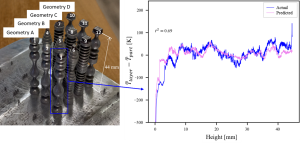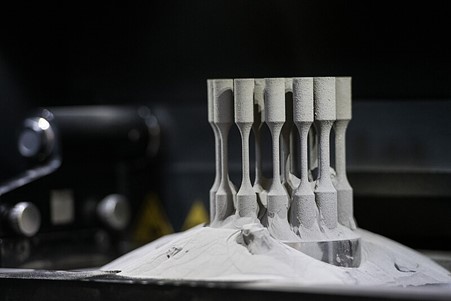Assistant professor Dominik Kozjek, a researcher in the Laboratory for Mechatronics, Production systems, and Automation (LAMPA) at the Faculty of Mechanical Engineering, UL, in cooperation with researchers from Northwestern University (Illinois, United States), the United States Army Research Laboratory, and the company DMG MORI Advanced Solutions, developed a new method of predicting meltpool temperature variations in the laser-powder bed fusion of metals (PBF-LB/M) process.
PBF-LB/M process can be used in industry to produce geometrically complex and high-performance metal parts, for example, medical implants, and engine and structural elements of aircrafts. PBF-LB/M supports sustainability through light-weighting, easing supply chain constraints, and enabling a high level of product customization. However, the inability to predict and control melting process condition variations and subsequent variations in final part quality leads to qualification and certification challenges, hence hinders the wide adoption of the PBF-LB/M process in medicine, automotive, and military industries. Methods, that are able to predict and control process condition variations are thus of critical importance for further advancement of the PBF-LB/M process.
The published study proposes an efficient artificial intelligence-based method to predict variations in meltpool temperature. The variations are predicted based on a training artificial intelligence-based prediction model with the dataset of previous in-situ coaxial meltpool temperature measurements. The method also considers surrounding parts on the build plate (usually in a single 3D printing build, several parts are printed together) which, as demonstrated in the results of this study, significantly affect meltpool temperature variations of the observed part.

Photo 1: Example of predicted differences between the average melt pool temperature of a layer and the average melt pool temperature of a whole part for one of the main test parts.
The strength of the proposed method is its efficiency. It was shown that with a small dataset and several minutes of processing on a regular PC, useful predictions of the meltpool temperature variations along the build direction of the observed part can be obtained. An important advantage of the proposed method is that the method is able to predict meltpool temperature variation profiles for new part geometries, previously unseen by the prediction model in the training process. Meltpool temperature variations can be predicted using only machine input data and previous meltpool temperature measurements of parts of different geometries as the target part geometry.
The research results were published in Additive Manufacturing (IF: 11.0), one of the top scientific journals in the field of mechanical engineering. By developing this new method of predicting variations in the average meltpool temperature, we are one step closer to ensuring the reliability and quality of the laser-powder bed fusion of metals process for the production of safety-critical parts.
